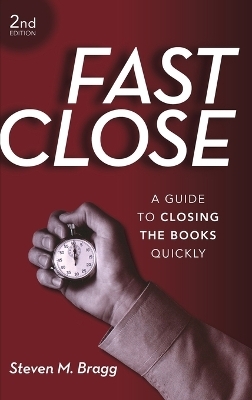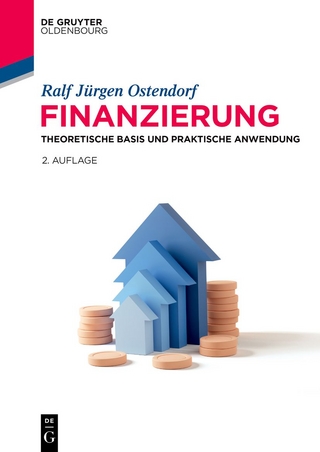
Fast Close
John Wiley & Sons Inc (Verlag)
978-0-470-46501-1 (ISBN)
- Lieferbar (Termin unbekannt)
- Versandkostenfrei innerhalb Deutschlands
- Auch auf Rechnung
- Verfügbarkeit in der Filiale vor Ort prüfen
- Artikel merken
Praise for Fast Close: A Guide to Closing the Books Quickly "Steve captures the essence of the problems affecting the financial close process within corporations of all sizes; from the period close of subledgers and general ledger through financial reporting, and the relationship and interdependencies of governance, people and technology. A must-read for the corporate controller."
—David Taylor, ACMA, MBA, VP Strategy, Trintech Inc.
"Fast Close: A Guide to Closing the Books Quickly, Second Edition is a must-read for today's busy controllers. Steven Bragg points out everything that can be done outside the close that you just never realized didn't actually have to be part of the month-end close process! Very commonsensical approach!"
—Kathleen Schneibel, mba, cpa, Controller/CFO for Hire, KMAS Consulting LLC
"A well-executed 'fast close' can bring many valuable benefits to any company, from improving organizational performance to transforming accounting executives from financial historians to trusted advisors. In Fast Close, Second Edition, Steve systematically breaks down the steps required to achieve a fast close in both public and private companies, providing financial executives with tips, checklists, and a cost-effective road map to implement fast close procedures in virtually any company."
—Matthew Posta, Esq., CPA, Vice President of Finance, Key Air, LLC
FROM THE FIRST EDITION
"This is an outstanding book in which Steve reveals his secrets to a fast close. Having personally experienced his (one-day) fast close for years and enjoyed the beneficial impact on my company, I highly recommend this book for all financial officers who desire to have a large, favorable impact on their company."
—Richard V. Souders, President and CEO, Kaba Workforce Solutions
STEVEN M. BRAGG, CPA, has been the chief financial officer or controller of four companies, as well as a consulting manager at Ernst & Young and auditor at Deloitte & Touche. He received a master's degree in finance from Bentley College, an MBA from Babson College, and a bachelor's degree in economics from the University of Maine. He has been the two-time president of the Colorado Mountain Club, is an avid alpine skier and mountain biker, and is a certified master diver. Mr. Bragg resides in Centennial, Colorado. He is also the author of Accounting Best Practices and Accounting Policies and Procedures Manual, both published by Wiley.
Preface xv
Chapter 1 Introduction 1
Different Types of Fast Close 1
Benefits of the Fast Close 2
Legal Issues Impacting the Fast Close 3
Steps to Achieve a Fast Close 4
Summary 6
Chapter 2 Your Current Closing Process 7
Traditional Closing Process: Basic 7
Additional Closing Tasks for the Multidivision Company 11
Additional Closing Tasks for the Multinational Company 12
Additional Closing Tasks for the Public Corporation 12
Problems with the Closing Process 13
Summary 17
Endnote 17
Chapter 3 Conducting a Review of the Closing Process 19
Steps in the Process Review 19
Payables Process Review 22
Billing Process Review 22
Inventory Process Review 24
Cash Process Review 26
Final Closing Process Review 26
Total Duration of the Closing Process 29
Summary 29
Endnote 29
Chapter 4 Alter the Timing of Closing Activities 31
Altering the Closing Mindset 31
Review and Correct Subledger Transactions Throughout the Month 32
Complete the Bank Reconciliation Every Day 32
Review Uncashed Checks 33
Update the Inventory Obsolescence Reserve 33
Determine the Lower of Cost or Market 33
Calculate Overhead Allocation Bases 33
Bill Recurring Invoices 34
Conduct a Preliminary Comparison of the Shipping Log to Invoices Issued 35
Review Preliminary Rebillable Expenses 35
Update the Bad Debt Reserve 35
Review Preliminary Billable Hours 36
Accrue Interest Expense 36
Determine Pension Plan Funding 36
Determine Flexible Spending Account Funding 37
Accrue Unpaid Wages 37
Accrue Unused Vacation Time 38
Accrue Travel Expenses 38
Reconcile Asset and Liability Accounts 39
Calculate Depreciation 39
Compile Preliminary Commissions 40
Review Financial Statements for Errors 40
Complete Selected Financial Reports in Advance 41
Deferred Closing Activities 42
Summary 46
Chapter 5 Revise the Contents of the Financial Statements 47
Alter the Mode of Report Delivery 47
Standardize Reports 48
Eliminate Cost Reporting from the Reporting Package 49
Separate Metrics from the Financial Reporting Package 49
Summary 50
Chapter 6 Optimize the Use of Journal Entries and Chart of Accounts 51
Eliminate Immaterial Journal Entries 51
Standardize Journal Entries 52
Convert to Recurring Journal Entries 53
Centralize Use of Journal Entries 54
Use Journal Entries to Accrue Expenses Delaying the Close 54
Automate Journal Entry Postings 55
Use Accruals Only for External Reporting 55
Define Accounts 55
Standardize the Chart of Accounts 56
Automate Eliminations of Intercompany Transactions 57
Summary 57
Chapter 7 Standardization and Centralization 61
Impact of Standardization on the Closing Process 61
Impact of Centralization on a Multilocation Accounting Department 63
Impact of Centralization on a Single-Location Accounting Department 65
Incorporating Standardization and Centralization into Acquisition Activities 66
Summary 68
Chapter 8 Closing the Inventory Function 69
Create an Inventory Tracking System 69
Implement Cycle Counting 73
Reduce the Amount of Inventory 77
Properly Record the Lower of Cost or Market Rule 84
Reviewing Obsolete Inventory 85
Preventing Obsolete Inventory 87
Summary 89
Endnotes 91
Chapter 9 Closing the Billing Function 93
Bill Recurring Invoices in the Preceding Month 93
Computerize the Shipping Log 94
Eliminate Rebillable Expense Processing from the Core Closing Period 95
Eliminate Month-End Statements 96
Print Invoices Every Day 96
Transmit Transactions via Electronic Data Interchange 97
Summary 97
Endnote 99
Chapter 10 Closing the Payroll Function 101
Automatically Calculate Commissions in the Computer System 101
Simplify the Commission Structure 102
Install Incentive Compensation Management Software 103
Post Commission Payments on the Company Intranet 103
Avoid Adjusting Preliminary Commission Accrual Calculations 104
Use a Bar-Coded Time Clock 105
Use a Web-Based Timekeeping System 106
Automate Vacation Accruals 107
Merge Sick Time into Vacation Time 108
Cap the Amount of Vacation Time to Be Carried Forward 108
Summary 110
Endnote 110
Chapter 11 Closing the Payables Function 111
Automate the Month-End Cutoff 111
Pay Based on Receiving Approval Only 112
Automate Three-Way Matching 114
Reduce Required Approvals 115
Use Negative Assurance for Invoice Approvals 117
Use Procurement Cards 117
Have Suppliers Include Their Supplier Numbers on Invoices 122
Receive Billings Through Electronic Data Interchange 123
Request That Suppliers Enter Invoices Through a Web Site 124
Audit Expense Reports 125
Automate Expense Reporting 127
Link Corporate Travel Policies to an Automated Expense Reporting System 128
Issue a Standard Account Code List 129
Link Supplier Requests to the Accounts Payable Database 130
Automate Payments for Repetitive Processing 131
Eliminate Manual Checks 132
Use a Signature Stamp 133
Ignore Supplier Invoices and Pay from Statements 134
Issue Standard Adjustment Letters to Suppliers 135
Summary 135
Endnote 135
Chapter 12 Closing the Cash Processing Function 137
Access Bank Account Information on the Internet 137
Avoid Delays in Check Posting 138
Collect Receivables Through Lockboxes 138
Install a Lockbox Truncation System 140
Access Online Check Images from a Lockbox 141
Consolidate Bank Accounts 141
Summary 142
Endnote 142
Chapter 13 Impact of Automation on the Closing Process 143
Principles of Fast Close Automation 143
Implement Minor Programming Changes on an Ongoing Basis 144
Automate General Ledger Interfaces 145
Install a Web-Based Timekeeping System 145
Install a Workflow Management System 147
Install Consolidation Software 148
Install a data Warehouse 148
Install an Enterprise Resources Planning System 149
Summary 151
Chapter 14 Closing the Books of a Public Company 153
Overview 153
Constructing the SEC Filing 153
Quarterly Auditor Reviews and Audits 157
Quarterly Legal Review 160
Officer Certification 160
Audit Committee Approval 161
EDGARizing 162
Summary 162
Chapter 15 Controls for Financial Reporting 165
Overview 165
Controls for Financial Reporting 165
Summary 176
Chapter 16 Ongoing Improvements in the Closing Process 177
Ongoing Improvement Process 177
Improvement Measurements 179
Summary 180
Appendix A Comprehensive Closing Checklist 181
Appendix B Fast Close Policies and Procedures 185
Appendix C Soft Close Checklist 197
Appendix D Year-End Close Checklist 201
Index 205
| Zusatzinfo | Drawings: 0 B&W, 0 Color; Tables: 0 B&W, 0 Color; Exhibits: 22 B&W, 0 Color |
|---|---|
| Verlagsort | New York |
| Sprache | englisch |
| Maße | 160 x 236 mm |
| Gewicht | 440 g |
| Themenwelt | Wirtschaft ► Betriebswirtschaft / Management ► Finanzierung |
| ISBN-10 | 0-470-46501-8 / 0470465018 |
| ISBN-13 | 978-0-470-46501-1 / 9780470465011 |
| Zustand | Neuware |
| Informationen gemäß Produktsicherheitsverordnung (GPSR) | |
| Haben Sie eine Frage zum Produkt? |
aus dem Bereich


